The False Cross is an asterism formed by four bright stars in the constellations Vela and Carina. Located in the far southern sky, the diamond-shaped pattern is often confused for the Southern Cross, a smaller but brighter asterism commonly used in navigation to find the south celestial pole. Even though the False Cross does not point the way to true south and can cause errors in astronavigation, it can also be used to identify the four bright southern stars that form it and to find several interesting deep sky objects in Carina and Vela.
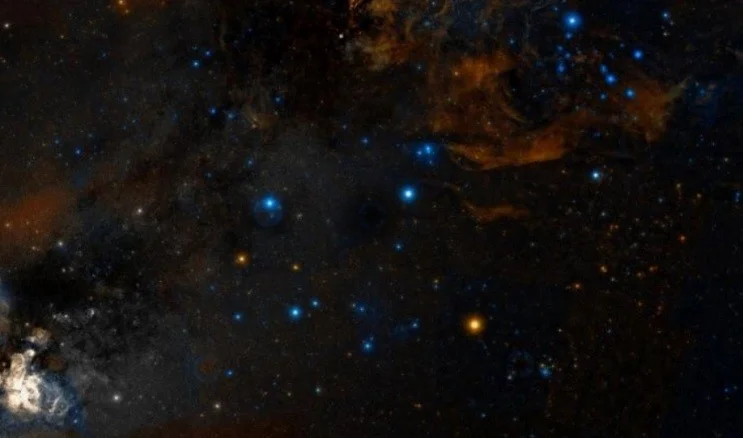
The False Cross, image: Wikisky
The Southern Cross, False Cross and Diamond Cross
The False Cross is formed by Avior (Epsilon Carinae), Alsephina (Delta Velorum), Aspidiske (Iota Carinae), and Markeb (Kappa Velorum). It is one of three cross asterisms in the southern sky. However, unlike the Northern Cross in Cygnus, the three southern asterisms do not really look like crosses. None of them have a prominent central star, which makes all three appear diamond or kite-shaped.
The False Cross is larger and fainter than the better-known Southern Cross, formed by the brightest stars in Crux (Acrux, Mimosa, Gacrux, Imai, and Ginan), but far more conspicuous than the Diamond Cross, formed by four relatively bright stars in Carina: Miaplacidus (Beta Carinae), Theta Carinae, Upsilon Carinae, and Omega Carinae.
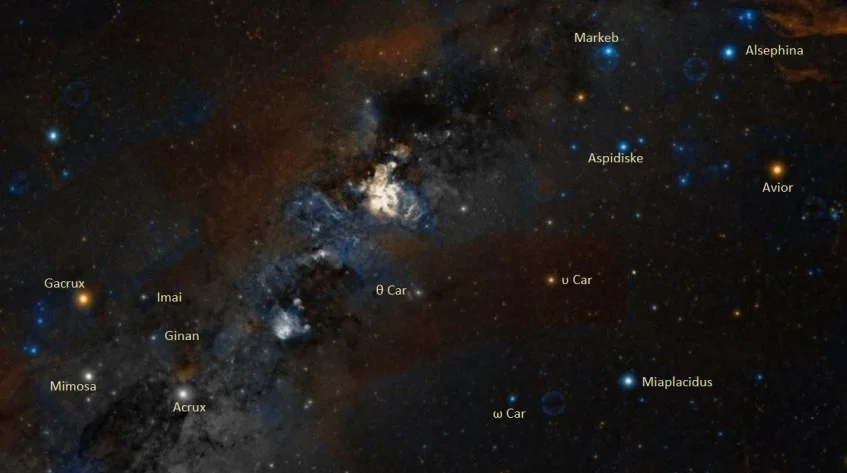
The Diamond Cross (centre), False Cross (right) and Southern Cross (left), image: Wikisky
The False Cross and the Southern Cross have several similarities: both are bright, diamond-shaped and formed by three white or blue-white stars and one contrasting reddish or orange star. However, the Southern Cross is much brighter. It contains two first-magnitude stars – Acrux and Mimosa – and it has a fifth star – Ginan (Epsilon Crucis) – appearing on the right side.
The easiest way to find the real Southern Cross is using the Southern Pointers, the bright stars Alpha and Beta Centauri. A line extended from Alpha Centauri, the third brightest star in the sky, through Hadar (Beta Centauri), the 11th brightest star, points toward Gacrux, the top star of the Southern Cross. The False Cross lies in the same area of the sky as Canopus, the second brightest star in the sky, but unlike Alpha Centauri, Carina’s brightest star does not have any first-magnitude neighbours.
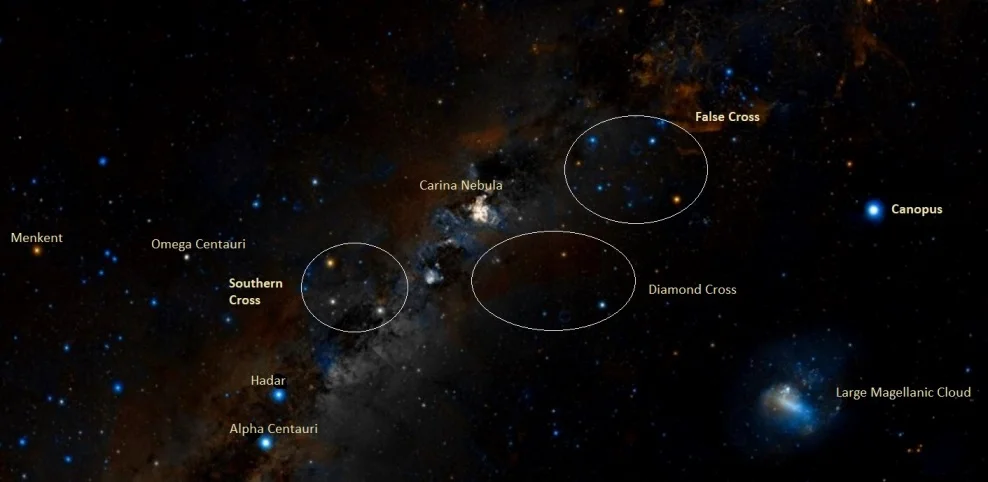
The Southern Cross, False Cross and Diamond Cross, image: Wikisky
The Diamond Cross lies roughly in the area between the two asterisms but is considerably fainter. It is the closest of the three to the Carina Nebula, one of the largest and brightest diffuse nebulae in the sky, which appears halfway between the Southern Cross and the False Cross.
Stars
The four bright stars that form the False Cross are Avior and Aspidiske in the constellation Carina and Alsephina and Markeb in the neighbouring Vela. At declinations between 54° and 60° S, the stars are largely invisible from mid-northern latitudes, but well-known to observers in the southern hemisphere.
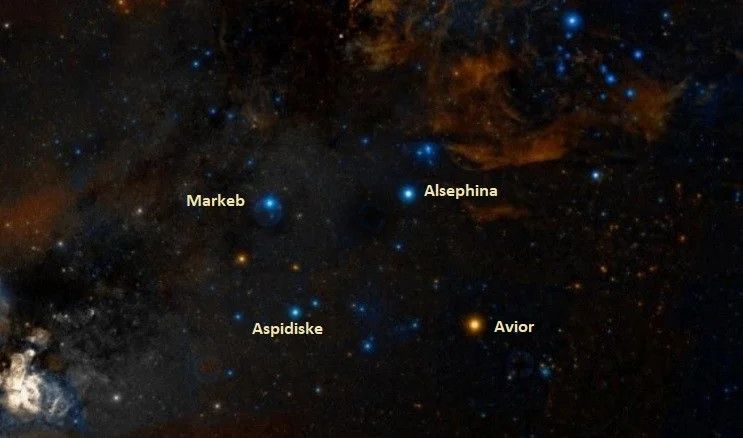
The stars of the False Cross, image: Wikisky
Avior – Epsilon Carinae
Avior (Epsilon Carinae) is the brightest of the four stars. It is the 40th brightest star in the sky and one of the 58 stars with a special status in the field of celestial navigation, along with its brighter Carina neighbours Canopus and Miaplacidus (Alpha and Beta Carinae).
Epsilon Carinae is not a single star. It is a spectroscopic binary composed of an orange giant, formally known as Avior, and a main sequence companion. With a combined apparent magnitude of 1.86, the star system is the third brightest point of light in Carina, after Canopus and Miaplacidus.
The orange giant, Epsilon Carinae A, has the stellar classification K3 III, while the fainter companion is a blue hydrogen-fusing dwarf of the spectral type B2 Vp. The stars orbit each other with a period of 785 days. As they orbit, they periodically eclipse each other, causing the visual magnitude to vary by 0.12.
Avior is older, cooler and more massive of the pair. It has a mass 10.5 times that of the Sun and a surface temperature of 3,523 K. Its estimated age is about 31.2 million years.
Epsilon Carinae B has a mass of 7.30 solar masses and is considerably hotter, with an effective temperature of 20,417 K. Its estimated age is 20 million years.
The Epsilon Carinae system lies at an approximate distance of 610 light years from Earth.
Alsephina – Delta Velorum
Delta Velorum is a triple star system composed of an eclipsing binary pair and a more distant companion. It is the second brightest point of light in Vela, after Regor (Gamma2 Velorum), with a combined apparent magnitude of 1.96. It lies at a distance of 80.6 light years from Earth.
The primary component in the system, Delta Velorum Aa, is formally named Alsephina. The name is derived from the Arabic al-safīnah, meaning “the ship.” It refers to the ship Argo, represented by the obsolete constellation Argo Navis, which was divided into three smaller ones – Carina, Puppis and Vela – in the 18th century. In Greek mythology, Argo was the ship on which Jason and the Argonauts sailed on their quest for the Golden Fleece.
The eclipsing binary star, designated Delta Velorum A, consists of two white, class A stars of the spectral types A2IV and A4V. The stars orbit each other with a period of 45.1503 days. They are separated by only 0.01651 arcseconds and cannot be resolved even in larger telescopes.
The primary component, Delta Velorum Aa, has a mass of 2.43 solar masses and a radius between 2.79 and 2.97 times that of the Sun. With an effective temperature of 9,440 K, it shines with 67 solar luminosities. The star spins at 143.5 km/s and takes 1.05 days to complete a rotation.
Delta Velorum Ab is slightly smaller and less massive. It has a mass of 2.27 solar masses and a radius between 2.37 and 2.52 solar radii. With a surface temperature of 9,830 K, it is 51 times more luminous than the Sun. The star has a projected rotational velocity of 149.6 km/s. Its estimated age is 400 million years.
Delta Velorum B orbits the main pair with a period of 143.2 years and is separated by 1.996 arcseconds from the binary. It is a white main sequence star of the spectral type F8V. It has a mass between 1.35 and 1.46 times that of the Sun and a radius 1.43 times solar. With an effective temperature of 6,600 K, it is 3.5 times more luminous than the Sun.
The Delta Velorum system has another likely companion, catalogued as HD 76653, at a physical separation of 2.2 light years.
Aspidiske – Iota Carinae
Aspidiske (Iota Carinae) is the fourth brightest star in Carina. It is a white supergiant of the spectral type A9 Ib. It has an apparent magnitude of 2.21 and lies approximately 690 light years away. The name Aspidiske comes from the Greek word for “little shield.”
Iota Carinae has a mass 7.4 times that of the Sun and has grown to a size of 43 solar radii. With a surface temperature of 7,500 K, it is 4,900 times more luminous than the Sun. The star’s estimated age is 37.4 million years. It spins with a projected rotational velocity of 10 km/s.
Markeb – Kappa Velorum
Markeb (Kappa Velorum) is the faintest of the four stars of the False Cross and the fourth brightest star in Vela, after Regor, Alsephina and Suhail. It has an apparent magnitude of 2.48 and lies 570 light years away. The name Markeb comes from the Arabic markab, meaning “something to ride.”
Kappa Velorum is a spectroscopic binary star composed of two unresolved components in close orbit. The stars orbit each other with a period of 116.65 days. The parameters of the individual components are unknown. The system has the stellar classification B2 IV, indicating a blue subgiant star. The star’s estimated size is 6.9 times that of the Sun.
Deep sky objects
The area around the False Cross is home to many relatively bright deep sky objects. The brightest of these are the Omicron Velorum Cluster (IC 2391), the open clusters IC 2488 and NGC 2516, the reflection nebula IC 2220, and the globular cluster NGC 2808.
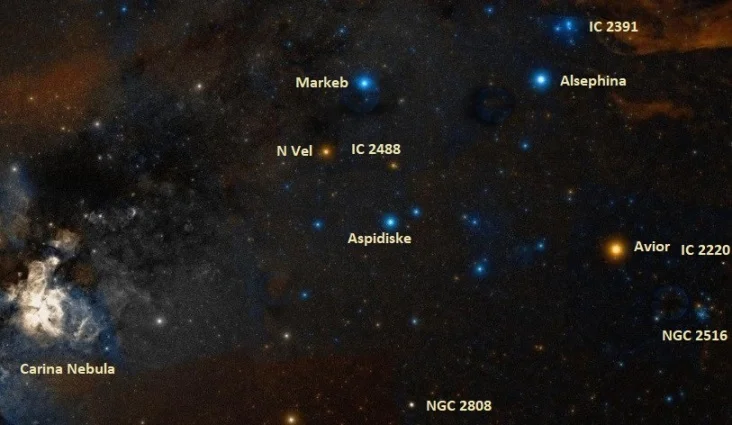
The deep sky objects near the False Cross, image: Wikisky
Located just north of Alsephina, the Omicron Velorum Cluster (IC 2391) occupies 50 arcminutes of the apparent sky. With an apparent magnitude of 2.5, it is visible to the unaided eye. The brightest star in the cluster, the blue subgiant Omicron Velorum, has a mean apparent magnitude of 3.60. It is classified as a slow pulsating variable and its brightness varies from magnitude 3.57 to 3.63. The star lies approximately 490 light years away. The smaller open cluster NGC 2669 appears just east of IC 2391.
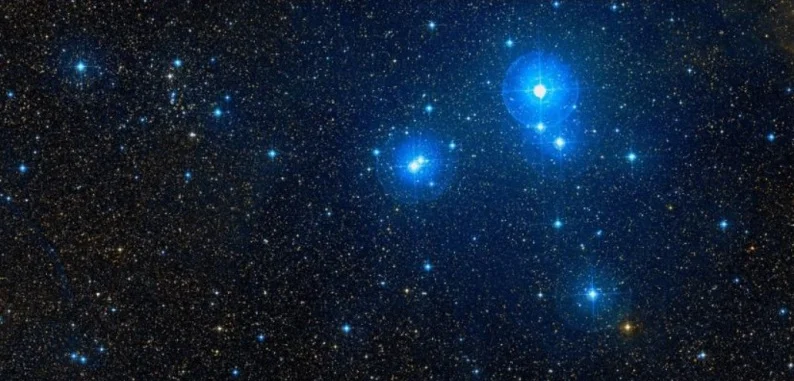
The Omicron Velorum Cluster (IC 2391) and NGC 2669 (left), image: Wikisky
The open cluster IC 2488 is considerably fainter, with an apparent magnitude of 7.4. It also lies at a much greater distance, about 3,700 light years away. It occupies 15 arcminutes of the sky near the orange giant star N Velorum (mag. 3.16). The cluster appears 30 arcminutes west of N Velorum.
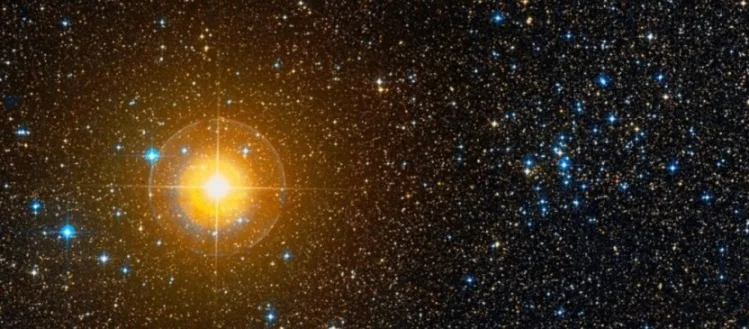
N Velorum and IC 2488, image: Wikisky
Located southwest of Avior, the open cluster NGC 2516 appears as a hazy patch to the unaided eye and is easily resolved into stars with binoculars. The cluster has an apparent magnitude of 3.8 and an apparent size of 30.0 arcminutes. It is also known as the Sprinter or the Southern Beehive because it resembles the larger Beehive Cluster (Messier 44) in the constellation Cancer.
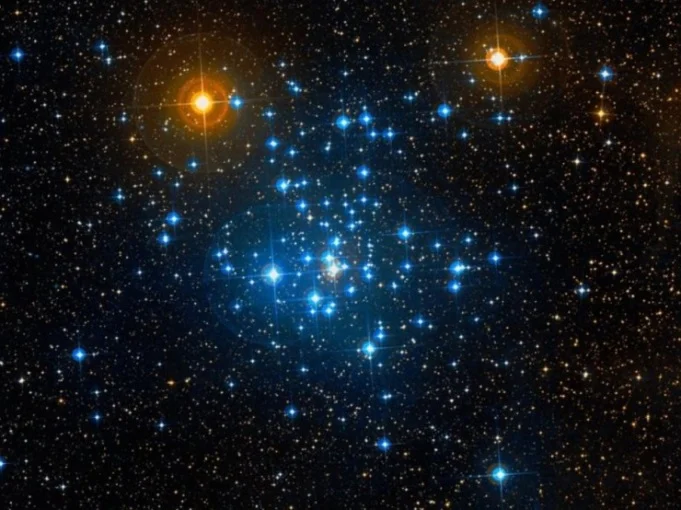
The Southern Beehive Cluster (NGC 2516), image: Wikisky
The reflection nebula IC 2220 appears just north of the Southern Beehive. Also known as the Toby Jug Nebula, it occupies an area 8 by 8 degrees in size. The nebula lies approximately 1,200 light years away. It reflects the light of the bright red giant V341 Carinae (HD 65750).
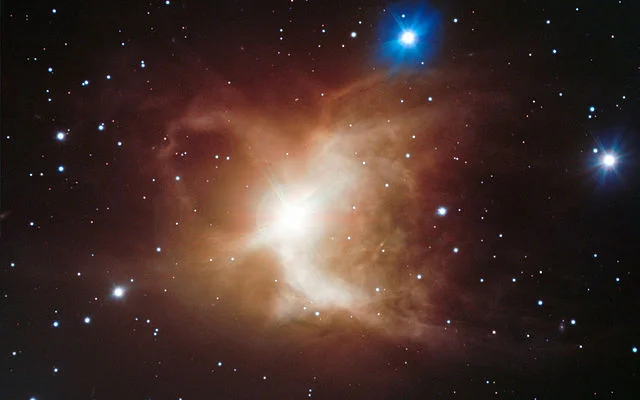
Located about 1200 light-years from Earth in the southern constellation of Carina (The Ship’s Keel), the Toby Jug Nebula, more formally known as IC 2220, is an example of a reflection nebula. It is a cloud of gas and dust illuminated from within by the central star, designated HD 65750. Image: ESO
The globular cluster NGC 2808 can be found along an imaginary line extended from Markeb through Aspidiske. It has an apparent magnitude of 6.2 and occupies 13.8 arcminutes of the apparent sky. Containing over a million stars, NGC 2808 is one of the most massive clusters in the Milky Way.
In 2007, the cluster challenged the belief that globular clusters could only produce a single generation of stars when it was discovered to contain three. All three generations of stars in NGC 2808 formed within the first 200 million years of the formation of the cluster. A theory has been proposed that NGC 2808 is in fact what used to be the core of a dwarf galaxy known as the Gaia Sausage or the Sausage Galaxy, that collided with the Milky Way about 8 – 11 billion years ago.
The estimated age of the cluster is 12.5 billion years. It lies 31,300 light years away.
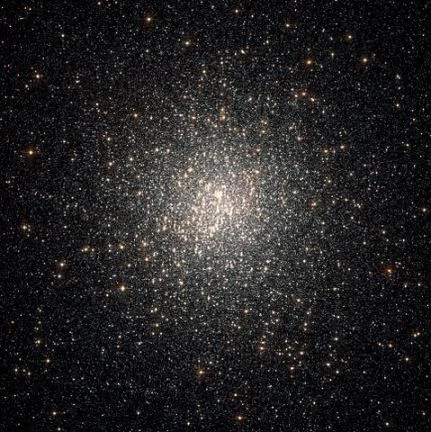
This Hubble Space Telescope (HST) image of a dense swarm of stars shows the central region of the globular cluster NGC 2808 and its three generations of stars. Image: NASA, ESA, A. Sarajedini (University of Florida) and G. Piotto (University of Padova)